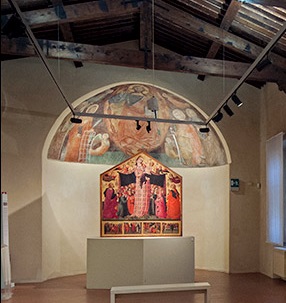The Arezzo Museum of Medieval and Modern Art

The Arezzo Museum of Medieval and Modern Art, located in the Bruni Ciocchi Palace in the historic center, is an immersion in history and art, with roots dating back to the Villanovan period of the Etruscan Era. Originally funded by Donato Bruni in the 19th century and used for various historical purposes, the palace now houses the museum, which opened in 1972. With three floors devoted to reliefs, sculptures, paintings, coins, weapons and jewelry, the museum features significant works such as Giorgio Vasari's "Convite for the Marriage of Esther and Ahasuerus." The Fraternita dei Laici, founded in 1262, has contributed to the financing of city art, emphasizing Arezzo's historical connection to its glorious past. Open daily with free admission, the museum is an essential stop for those visiting Arezzo, easily accessible from the Poggio del Drago B&B, offering an ideal starting point for exploring Arezzo's rich culture.
The Arezzo Museum of Medieval and Modern Art : A Journey through History and Art – For those who are passionate about art and history, a visit to the Museum of Medieval and Modern Art in Arezzo is essential. Strategically located in the city’s historic center, the museum is housed in the Palazzo Bruni Ciocchi at 8 Via San Lorentino, a building of great historical importance to Arezzo. The palace, originally financed by Donato Bruni, son of the noted humanist Leonardo Bruni, later passed into the hands of the Ciocchi family of Monte San Savino and then to the Counts Barbolani di Montauto in the 17th century, who made significant changes.
History of the Palace
Beginning in the 19th century, the palace became the property of the Grand Duchy of Tuscany, used as a warehouse for goods subject to the State Monopoly and the Customs Offices, earning it the appellation “Palazzo della Dogana.” This rich and varied past makes a visit to the Bruni Ciocchi Palace a historical immersion, retracing the steps of ladies, knights, clergymen and officials who have walked these spaces.
The Arezzo Museum of Medieval and Modern Art at the Present
.
During the 1950s, the Bruni Ciocchi Palace was selected as the site of the museum, which officially opened in 1972. Occupying three floors, the museum holds a remarkable collection of artworks and historical artifacts, including a restoration workshop located in the former lemon house. The museum’s collections are deeply connected with the history of Arezzo, many of which originate from the collections of the City of Arezzo or the Fraternita dei Laici.
Contribution of the Fraternita dei Laici
The Fraternita dei Laici, established in 1262, played a key role in supporting city art, funding various works, including those of Giorgio Vasari. Their influence helped preserve Arezzo’s historical link to its glorious past.
Discovering the Arezzo Museum of Medieval and Modern Art
The ground floor of the museum displays reliefs, medieval and Renaissance sculptures, and architectural fragments. The adjacent room is dedicated to sculptures from churches in Arezzo. On the second floor, visitors can admire a wide range of paintings, coins, weapons, jewelry, and frescoes made by Spinello Aretino and his son Parri. Giorgio Vasari’s “The Wedding Banquet of Esther and Ahasuerus,” one of the major panel paintings of the 1500s, is displayed in one of the museum’s corridors. The tour continues with a collection of Italian majolica and concludes on the upper floor with a variety of art objects and weapons dated between the 16th and 20th centuries.
Practical Information
The Arezzo State Museum of Medieval and Modern Art is open daily, except Mondays, from 8:30 a.m. to 7:30 p.m., with free admission. The museum represents a crucial stage in the cultural and historical journey of downtown Arezzo.
B&B Poggio del Drago and the Proximity to the Arezzo Museum of Medieval and Modern Art
The B&B Poggio del Drago, located in close proximity to the city of Arezzo and other historic attractions, offers a cozy and familiar environment, ideal for those who wish to immerse themselves in Arezzo’s art and culture. Its location makes it easy to explore places of interest such as Piazza Grande, the Basilica of San Francesco, the House of Giorgio Vasari, and of course the State Museum of Medieval and Modern Art. Poggio del Drago is an excellent base for visiting other Tuscan cities as well! Read more on our website.
The Historic Center of Arezzo
In the historic heart of Arezzo, the Museum of Medieval and Modern Art is surrounded by picturesque views and lively squares, offering an authentic immersion in the atmosphere of a city with a long history.




